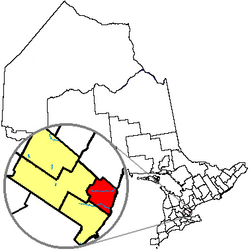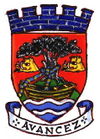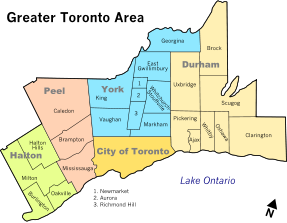Oakville, Ontario
| Town of Oakville | |||
|---|---|---|---|
| — Town — | |||
|
|
|||
|
|||
| Motto: Avancez (French) (Go forward)[1] | |||
 |
|||
| Coordinates: | |||
| Country | |||
| Province | |||
| Region | Halton | ||
| Wards | 6 | ||
| Neighbourhoods | 12 | ||
| Established | 1827 | ||
| Government | |||
| - Town Mayor | Rob Burton | ||
| - Governing Body | Oakville Town Council | ||
| - MPs | Terence Young Lisa Raitt |
||
| - MPPs | Ted Chudleigh Kevin Flynn |
||
| Area[1] | |||
| - Total | 138.51 km2 (53.5 sq mi) | ||
| Elevation | 173 m (568 ft) | ||
| Population (2006) | |||
| - Total | 165,613 (Ranked 26th) | ||
| - Density | 1,195.2/km2 (3,095.6/sq mi) | ||
| [2] | |||
| Time zone | Eastern (EST) (UTC−5) | ||
| - Summer (DST) | EDT (UTC−4) | ||
| Postal code span | L6(H,J,K,L,M) | ||
| Website | Town of Oakville Official Website | ||
| [1] Stats Canada | |||
Oakville (2006 population 165,613 [2]) is a town in Halton Region, on Lake Ontario in Southern Ontario, Canada, and is part of the Greater Toronto Area.
Contents |
History
In 1793, Dundas Street was surveyed for a military road. In 1805, the Legislative Assembly of Upper Canada bought the lands between Etobicoke and Hamilton from the Mississaugas aboriginal people, except for the land at the mouths of Twelve Mile Creek (Bronte Creek), Sixteen Mile Creek, and along the Credit River. In 1807, British immigrants settled the area surrounding Dundas Street as well as on the shore of Lake Ontario.
In 1820, the Crown bought the area surrounding the waterways. The area around the creeks, 960 acres (approximately 4 km²), ceded to the Crown by the Mississaugas[3], was auctioned off to William Chisholm in 1827. He left the development of the area to his son, Robert Kerr Chisholm and his brother-in-law, Thomas Merrick.
Oakville's first industries included shipbuilding, timber shipment, and wheat farming. In the 1850s, there was an economic recession and the foundry, the most important industry in town, was closed. Basket-making became a major industry in the town, and the Grand Trunk Railway was built through it.
The town eventually became industrialized with the opening of Cities Service Canada (later BP Canada, and now Petro Canada) and Shell Canada oil refineries (both now closed), the Procor factory, and, most importantly, the Ford Motor Company's Canadian headquarters and plant, all close to the Canadian National Railway and the Queen Elizabeth Way highway between Toronto and Fort Erie (Buffalo).
In 1962 the town of Oakville merged with its neighbouring villages (Bronte, Palermo, Sheridan, and the remainder of Trafalgar Township) to become the new Town of Oakville, reaching northwards to Steeles Avenue in Milton. In 1973, the restructuring of Halton County into Halton Region brought the northern border southwards to just north of Highway 407
Neighbourhoods
Oakville's Planning Department divides the town into communities. These divisions have little to do with politics and are based on traditional neighbourhoods.[4]
Old Oakville
Old Oakville is located in South-Central Oakville along the shore of Lake Ontario. It is the original Oakville Settlement and is centred on Oakville Harbour.[5]
Bronte
Bronte is located in Southwest Oakville along the shore of Lake Ontario. It is a community centred on Bronte Harbour and includes the Coronation Park district to its east.[6]
Eastlake
Eastlake is located in Southeast Oakville along the shore of Lake Ontario, also referred to as Joshua Creek. It is bordered on the west by Morrison Creek, to the north by Cornwall Road, and to the east by the Mississauga border.[7]
Clearview
Clearview is located in Centre East Oakville.[8]
College Park
College Park is located between Sixteen Mile Creek and just east of Trafalgar Road, from the Queen Elizabeth Way north to Upper Middle Road. It surrounds Sheridan College.[9]
Iroquois Ridge North
Iroquois Ridge North is located in North East Oakville between Upper Middle Road and Dundas Street.[10]
Iroquois Ridge South
Iroquois Ridge South is located in North East Oakville. The Falgarwood area is located in the southern end of the Iroquois Ridge South community.[11]
Glen Abbey
Glen Abbey is located in West Oakville, with Third Line being the major artery of the community. It is a large area west of the Glen Abbey Golf Course, home of the Canadian Open,[12]
Palermo
Palermo is located in Northwest Oakville. It is a small community centred on the intersection of Dundas Street and Bronte Road (Highway 25).[13]
River Oaks
River Oaks is located in North-Central Oakville. It includes the Oak Park development.[14]
Uptown Core
Uptown Core is located in North Centre Oakville. It includes the area on either side of Trafalgar Road between Dundas Street and Glenashton Drive.[15]
West Oak Trails
West Oak Trails is located in North Centre West Oakville. It is a newer development than the other communities.[16]
Demographics
| Census | Population |
|---|---|
| 1841 | 550 |
| 1871 | 1,684 |
| 1901 | 1,643 |
| 1911 | 2,372 |
| 1921 | 3,298 |
| 1931 | 3,857 |
| 1941 | 4,115 |
| 1951 | 6,910 |
| 1961 | 10,366 |
| 1971 | 61,483 |
| 1981 | 75,773 |
| 1991 | 114,670 |
| 2001 | 144,738 |
| 2006 | 165,613 |
According to the 2006 Canadian Census Oakville had 165,613 residents. This represents a 14.4% increase since the 2001 Census.
According to the 2006 census, Oakville had a younger population than Canada as a whole. Minors (youth under 19 years of age) totalled 28.1 percent of the population compared to pensioners who number 11.7 percent. This compares with the Canadian average of 24.4 percent (minors) and 13.7 percent (pensioners).[17]
| Ethnic Origin[18] | Population | Percent |
|---|---|---|
| English | 47,920 | 29.13% |
| Scottish | 34,055 | 20.70% |
| Irish | 30,795 | 18.72% |
| German | 15,490 | 9.41% |
| Italian | 15,195 | 9.23% |
| French | 13,905 | 8.45% |
| Polish | 8,865 | 5.38% |
Because of its proximity to Toronto, Oakville is becoming increasingly diverse. As of 2006, 81.2% of the population was white. Other groups include South Asian: 6.0%, Chinese: 3.2%, black: 2.1%, and mixed race: 2%[17]
79.4% of residents stated their religion as Christian, almost evenly split between Roman Catholics and Protestants. Non-Christian religions include Islam: 2.0%, Hinduism: 1.3%, Sikhism: 1.1%, and Judaism: 0.7%. 14% indicated no religion.
The median household income was $83,982 with an average house value of $306,209. Oakville is among the most affluent municipalities in Canada.
Sports
Oakville has a long history of sporting. The only recognized professional sports team in Oakville is the Oakville Blue Devils of Canadian Soccer League. The Blue Devils are affiliated with the Oakville Soccer Club, which is the biggest soccer club in Canada.[19] The other professional team is the Oakville Ice women's ice hockey team of the NWHL. Oakville is home to the Oakville Crusaders Rugby club, the largest in Canada, Crusaders also has the biggest junior rugby program in Canada.
Oakville also has a moderate amount of success in hockey with the Oakville Blades, a Tier II Junior "A" franchise since 1966, and a "AAA" hockey system. The current rep hockey team in Oakville is the Oakville Vikings and Oakville Hornets Oakville Venum, and Oakville Rangers. The town also has the Oakville Buzz, a Junior "B" lacrosse team who won the Founders Cup in 2006. The current rep lacrosse team is the Oakville Hawks. There is also the Oakville Aquatic Club.
Oakville has the largest Little League Organization in all of Canada. Having the Oakville Whitecaps as their All-star team. Their main field for 12U and under is Chartwell Field were the Home office is.
Glen Abbey Golf Course, site of several Canadian Open professional golf championships and many other amateur tournaments, is also located in Oakville.
Events
Downtown Oakville Jazz Festival
The Downtown Oakville Jazz Festival is an annual jazz festival that has been taking place since 1992. This event includes free concerts on 5 stages along Lakeshore Road during the weekend.
Waterfront Festival
Oakville was home to its own annual Waterfront Festival. The Oakville Waterfront Festival was an event that the whole town was anxious to attend each year. The event usually consists of small amusement park rides, concerts from Canada's most popular bands, for example Hedley in the 2008 Oakville Waterfront Festival, and of course food and drinks. The Waterfront Festival took place sometime at the end of June each year. The Waterfront Festival was hosted at Oakville's Coronation Park with a view of Lake Ontario. Unfortunately, it was canceled in 2010 because it never turned a profit [20] .
For the Love of the Arts Festival
Once a year, usually in late spring, Oakville's arts and music groups get together for the Love of the Arts Festival. Hosted by CommUnity Arts Space [1], a local umbrella groups that has been advocating for a shared physical space for Oakville's arts and cultural groups since 2002, this festival is the only multi-disciplinary community festival of its kind in town and showcases local talent, skills, crafts, literary art, dance performances, theatre groups, music performances and much more. A symbolic presentation of a "shared space", the one-day event is entirely sponsored by local corporate and private donations and helps to nurture friendships and understanding between participants and visitors alike.
Midnight Madness
Once a year, Oakville has a huge sale right at Midnight, known as Midnight Madness. Many vendors come out with new products and lots of sales that go even into the 90 percentile. Hosted in Downtown Oakville in July, this is one of the biggest events of the year.
Education
Elementary schools and high schools in Oakville are a mix of private and public schools, with one of the highest ratios of private schools to student population in the country. Oakville is covered by the Halton District School Board, Halton Catholic District School Board, Conseil scolaire de district du Centre-Sud-Ouest, and Conseil scolaire de district catholique Centre-Sud.
The city is home to Appleby College, a private school established in 1911, that has produced a number of notable alumni such as Dan Hays, former Leader of the Opposition in the Senate, or more recently Canadian Olympian Jeff Batchelor. Oakville is also home to Sheridan College, a renowned animation and business studies institute, and Oakville's only higher education facility.
Government
Municipal and regional
At the municipal level, the governing body is the Oakville Town Council consisting of a mayor (currently Rob Burton) and twelve councillors. The town is divided into six wards, with two councillors elected by residents of each ward.
In each ward one councillor represents the ward solely on Oakville Town Council, and the other is a member of the 21-member governing council of the Regional Municipality of Halton, in addition to being a member of the 13-member Town Council.
Provincial
Oakville is situated in two provincial ridings which use the same boundaries as the federal ridings and are currently represented provincially by:
- Oakville Riding: Kevin Flynn (Liberal)
- Halton Riding: Ted Chudleigh (PC)
Federal
Oakville is situated in two federal ridings which are currently represented by:
- Oakville Riding: Terence Young (Conservative)
- Halton Riding: Lisa Raitt (Conservative)
Arts and culture
The Oakville Arts Council
The Oakville Arts Council (OAC) promotes arts and culture in Oakville. Formed in 1978, the Council is a not-for-profit charitable, umbrella organization representing a large and diverse membership from the Oakville arts community. Its mission is to cultivate the arts and to enrich the creative life of the Community of Oakville. The OAC provides a collective voice for, and is the most comprehensive resource for the Arts in Oakville - connecting the public to more than 300 individual artists, arts groups and business members, their exhibitions, events and classes. Members are entitled to a variety of services intended to enable artistic pursuits including promotional, educational, networking and training opportunities. The Council publishes Arts About Town, Oakville's only magazine dedicated to local artists and arts issues. For more information about the Oakville Arts Council’s services or to visit their up-to-date calendar of local art events visit www.oakvillearts.com.
Oakville Centre for the Performing Arts
The Oakville Centre for the Performing Arts houses several performances by local and international artists. It is also the performing venue for the Oakville Symphony Orchestra and the Oakville Ballet Company. The Oakville Arts Council provides further artistic talents in the town showcasing films, literary figures and visual arts.
CommUnity Arts Space
The Town of Oakville boasts many not-for-profit artistic, musical and cultural groups. These groups have been struggling to develop membership and programming due to lacking physical spaces. The groups joined forces in 2004, advocating for a shared space for arts, music and culture in Oakville, spearheaded by an advocacy group called CommUnity Arts Space (CUAS). CUAS has worked for a shared home for the arts and cultural groups for many years and is looking forward to the opening of Oakville's newest community centre in the former Queen Elizabeth Park (QEP) high school in Bronte, Oakville, in September 2011. The 140,000 sq ft. facility, owned and operated by the Town of Oakville, will provide easy access to recreational, cultural and artistic programmes for residents of all ages, and will provide an enormous range of opportunities for joint programmes, events and educational opportunities.
Oakville Galleries
Oakville Galleries is a public art museum owned by the Town of Oakville and operated by a non-profit corporation. It consists of two operations: Centennial Gallery, located in downtown Oakville; and Gairloch Gallery, located in East Oakville. Oakville Galleries is governed by an a board of directors elected by members and the Town.
Sister cities
Oakville is twinned with the cities of Dorval,[21] in Quebec, and Neyagawa,[22] Japan. The Town of Oakville has named two major streets for these cities.
Media
Oakville is primarily served by media based in Toronto with markets in the Greater Toronto Area (GTA) that cover most of the news in the GTA. However, Oakville also has two regional newspapers. The Oakville Beaver is published every Wednesday, Thursday and Friday and Oakville Today is published every Thursday.
The town also has two specialty radio stations: AM 1250 CJYE, a Christian music station and AM 1320 CJMR, a Multicultural station.
The following national cable television station also broadcast from Oakville:
- The Weather Network, broadcasts nationally from Oakville since 2005
- Hamilton based Television station CHCH-TV serves Hamilton, Halton and Niagara, thus including Oakville. CHCH recently closed its Halton Bureau (due to budget considerations) which was located in downtown Oakville.
- TVCogeco from the studio in the Cogeco Cable Headquarters at Harvester Road & Burloak Drive, just inside of Burlington.
Transportation
- Oakville Transit provides local bus service.
- GO Transit commuter rail and bus service operates from Bronte and Oakville stations.
- VIA Rail services along the line between Windsor and Quebec corridor
See also
- Category:People from Oakville, Ontario
- List of people of Oakville, Ontario
- List of schools in Oakville, Ontario
References
- ↑ "Coat of Arms". Town of Oakville. http://www.oakville.ca/coatofarms.htm. Retrieved 2007-12-30.
- ↑ 2.0 2.1 Statistics Canada. 2007. Oakville, Ontario (table). 2006 Community Profiles. 2006 Census. Statistics Canada Catalogue no. 92-591-XWE. Ottawa. Released March 13, 2007.
- ↑ "Illustrated Historical Atlas of Halton County (1877)". Waler & Miles. http://www.halinet.on.ca/localhistory/Page.asp?PageID=169. Retrieved 2008-05-26.
- ↑ "Town of Oakville Official Plan". Town of Oakville. 2006-09-30. pp. 130. http://www.oakville.ca/Media_Files/Offical_Plan_2006_consolidation.pdf. Retrieved 2008-09-30.
- ↑ "Old Oakville Community Profile". Town of Oakville. 2005. http://www.oakville.ca/Media_Files/OldOakville.pdf. Retrieved 2008-09-30.
- ↑ "Bronte Community Profile". Town of Oakville. 2005. http://www.oakville.ca/Media_Files/Bronte.pdf. Retrieved 2008-09-30.
- ↑ "Eastlake Community Profile". Town of Oakville. 2005. http://www.oakville.ca/Media_Files/Eastlake.pdf. Retrieved 2008-09-30.
- ↑ "Clearview Community Profile". Town of Oakville. 2005. http://www.oakville.ca/Media_Files/Clearview.pdf. Retrieved 2008-09-30.
- ↑ "College Park Community Profile". Town of Oakville. 2005. http://www.oakville.ca/Media_Files/CollegePark.pdf. Retrieved 2008-09-30.
- ↑ "Iroquois Ridge North Community Profile". Town of Oakville. 2005. http://www.oakville.ca/Media_Files/IRNorth.pdf. Retrieved 2008-09-30.
- ↑ "Iroquois Ridge South Community Profile". Town of Oakville. 2005. http://www.oakville.ca/Media_Files/IRSouth.pdf. Retrieved 2008-09-30.
- ↑ "Glen Abbey Community Profile". Town of Oakville. 2005. http://www.oakville.ca/Media_Files/GlenAbbey.pdf. Retrieved 2008-09-30.
- ↑ "Palermo Community Profile". Town of Oakville. 2005. http://www.oakville.ca/Media_Files/PalermoWest.pdf. Retrieved 2008-09-30.
- ↑ "River Oaks Community Profile". Town of Oakville. 2005. http://www.oakville.ca/Media_Files/RiverOaks.pdf. Retrieved 2008-09-30.
- ↑ "Uptown Core Community Profile". Town of Oakville. 2005. http://www.oakville.ca/Media_Files/UptownCore.pdf. Retrieved 2008-09-30.
- ↑ "West Oak Trails Community Profile". Town of Oakville. 2005. http://www.oakville.ca/Media_Files/WestOakTrails.pdf. Retrieved 2008-09-30.
- ↑ 17.0 17.1 "Community highlights for Oakville". 2006 Census Data. Statistics Canada. 2008-04-30. http://www12.statcan.ca/english/census06/data/profiles/community/Details/Page.cfm?Lang=E&Geo1=CSD&Code1=3524001&Geo2=PR&Code2=35&Data=Count&SearchText=Oakville&SearchType=Begins&SearchPR=01&B1=All&Custom=. Retrieved 2008-06-04.
- ↑ "Ethnic origins, 2006 counts, for census subdivisions (municipalities) with 5,000-plus population - 20% sample data". 2006 Census Data. Statistics Canada. 2008-04-01. http://www12.statcan.ca/english/census06/data/highlights/ethnic/pages/Page.cfm?Lang=E&Geo=CSD&Code=3524001&Data=Count&Table=2&StartRec=1&Sort=3&Display=All&CSDFilter=5000. Retrieved 2008-06-04.
- ↑ OSC Newsletter
- ↑ "Plug pulled on Oakville Waterfront Festival". InsideHalton. 2009-12-03. http://www.insidehalton.com/news/article/437645.
- ↑ MacKinnon, Bobbi-Jean (1992-05-28). "People-to-people appeal for Canada growing". Toronto Star: p. MA.6. http://pqasb.pqarchiver.com/thestar/access/454427461.html?dids=454427461:454427461&FMT=ABS&FMTS=ABS:FT&type=current&date=May+28%2C+1992&author=Bobbi-Jean+MacKinnon+Toronto+Star&pub=Toronto+Star&desc=People-to-people+appeal+for+Canada+growing&pqatl=google. Retrieved 2009-08-28.
- ↑ "Oakville's Sister City - Neyagawa, Japan". Oakville.ca. Town of Oakville. Archived from the original on 2009-08-28. http://www.webcitation.org/5jMq5eUY1. Retrieved 2009-08-28.
External links
 |
Milton |  |
||
| Burlington | Mississauga | |||
| Lake Ontario |
|
||||||||||||||||||||||||||
|
|||||
|
||||||||||||||||||||||||

